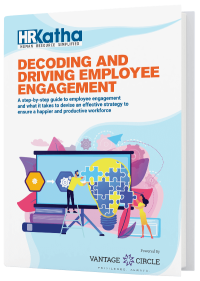People Analytics Will Be Important For The Future of HR

“Without data, you're just another person with an opinion.”- W. Edwards Deming
The world has become tech-based. That's old news. But what's new is the emergence and influence of big data and analytics. Data analysts are in demand, and for a good reason. A study by IBM shows that almost 2.5 quintillion bytes of data are created every day. And somebody needs to conclude all this data generation.
Human Resources also has finally realized the importance of data. Big data in the form of people analytics is being increasingly used to recruit, retain and make important decisions related to employees.
What Is People Analytics?
People analytics or HR analytics or talent analytics refers to data that managers use to understand and make decisions about their workforce. It uses statistics, maths, and technology to large sets of talent data and uses it for managing these talents. Thus, people analytics is the data-driven approach to managing people at work.
Both small and big organizations can use people analytics to manage their workforce and improve their levels of employee engagement. Companies looking for a better return on their investments in people will significantly benefit from people analytics (all companies).
The Problem
A research by Bersin found that 78 percent of large companies have rated analytics a “urgent” while only 7% of organisations feel they have “strong” HR data analytics resources.
In the 2017 People Analytics world conference held in Wharton, experts said that the success of people analytics lies both in data and common sense. Ross Sparksman, global head of workforce planning at Facebook, says people analytics is,
“50% cold, hard statistics and 50% common sense.”
They say the issue faced by HR experts isn't that they don't have the available data. The problem is that they aren't asking the right questions. In fact, the biggest challenge isn't collecting data. It's building the qualitative skills required to analyze, interpret and communicate that data.
The Benefits Of People Analytics
Task Automation
HR does a lot of work that is repetitive and time-consuming. Research by EY shows that 93% of the time spent by HR personnel is on repetitive tasks. Having data analysis software can help make the job easier. Softwares like Robotic Process Automation (RPA) do work like filing, copying, and assisting complex multi-step processes. As a result, this lets HR leaders focus on other essential tasks like interpretation and decision making.
Related: The Influence of Technology in the Workplace
Improve Employee Experience
When you know what your employees want, you make better people decisions. With tools like behavioral analytics, you can get insights into your employee’s behavior. This can further help you to take actionable steps in favor of your employees’ needs and wants. Consequently, this will result in high employee productivity and improved employee experience.
Unbiased Decision Making
Because people analytics deals with many complex data, it enables leaders and managers to make fair and rational decisions. People analytics allows leaders to make unbiased data-driven decisions and not based on their personal preferences and prejudices.
How HR Can Use It
So, how can hr departments and business leaders use data correctly?
Make People Decisions
Data collection enables Human Resources to understand their employees, i.e., their humans. Data collection helps to make better decisions about HR functions like recruitment, attrition rates, performance management and talent management. It provides critical findings and insights for analysis and interpretation.
Recruit Efficiently
Hiring people can be long and tiring work. Going through countless resumes manually to shortlist suitable candidates is complex and laborious. Moreover, doing it manually also makes the process prone to errors and is time-consuming. The solution to this is recruitment analytics. Companies design algorithms that allow recruiters to find candidates, mine data from social media, infer their preferences, and track and measure their performance.
Analyse High Employee Turnover
The reasons for turnover may vary. The start to tackle this issue lies in figuring out where the problem lies and the impact it is having. Moreover, machine learning algorithms can figure out why employees are leaving and even figure out the employee who is most likely to leave. For example, Micron found that their workers were more likely to leave because they felt their job description didn't specify their objectives and goals.
Measure Performance
Performance management can be done by predictive analytics. Predictive analytics is the practice of extracting information from already existing data to determine relations, patterns, and trends that could arise. In addition, organizations can identify traits that reflect an individual's or team's performance. It also gives insight into the employee's preferences and the factors that might help boost their productivity.
Final Words
It's not just enough to extract and mine mounds of data. You need to know how to make sense of that data. Leaders or HR teams should have a basic knowledge of data literacy and analyze, interpret and draw conclusions from that data.

Vantage Circle is a simple AI-powered Rewards & Recognition Platform for upgrading your employee experience and engagement for better productivity.





